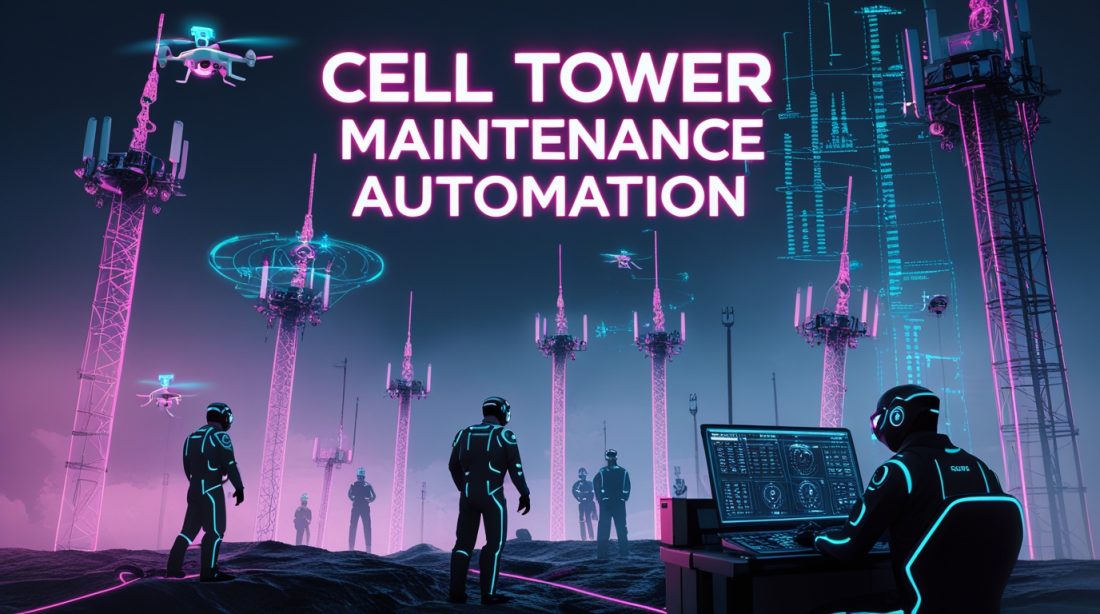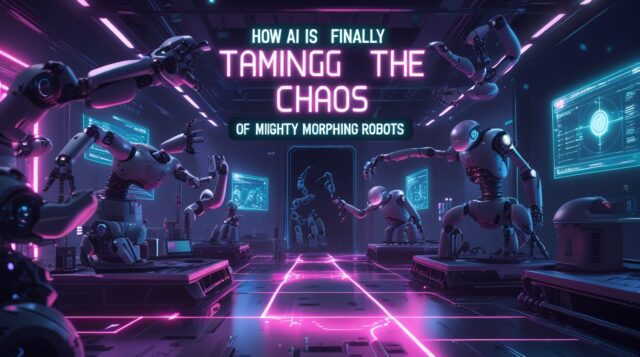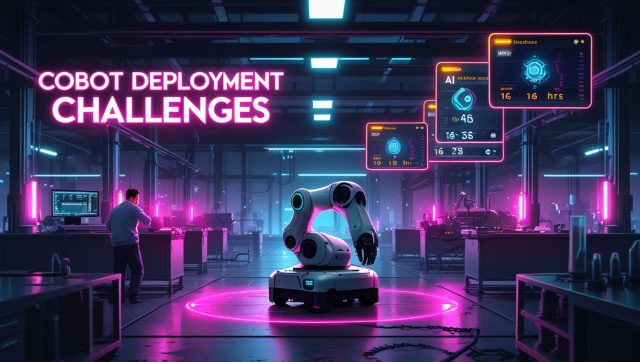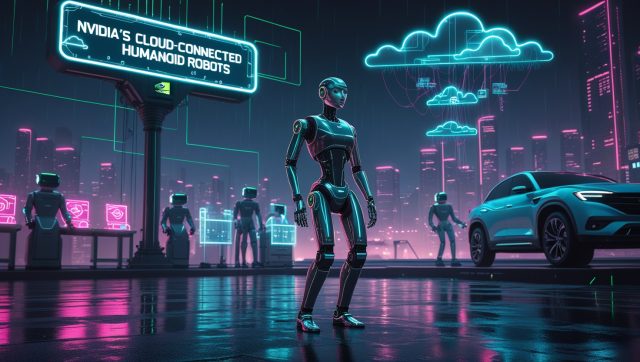For decades, maintaining cell towers has been one of the world’s most dangerous jobs. Industrial AI is finally changing that.
The work of climbing cell towers to install and maintain antennas is a high-stakes profession. Technicians, often called “steel monkeys,” work hundreds of feet in the air, manually handling heavy equipment while exposed to harsh weather and live electromagnetic radiation. A single misstep can be fatal. Today, a convergence of robotics and Industrial AI is creating a seismic shift, moving humans from precarious perches to the safety of the ground.
This article explores the critical evolution toward cell tower maintenance automation. We will examine the specific technologies making this possible, the tangible benefits being realized, and why this transformation represents a fundamental change in how the telecom industry manages its most vital—and most dangerous—infrastructure.
Why Cell Tower Maintenance Automation Is Urgently Needed for High-Risk Antenna Work
For years, the default process for antenna work has involved a human climb. This presents a cascade of challenges:
- Safety Risks: The fatality rate for tower climbers is significantly higher than the national average for all occupations.
- Operational Inefficiency: Climbing a several-hundred-foot tower is time-consuming, limiting the number of tasks a crew can complete in a day. Weather conditions, from high winds to extreme temperatures, frequently cause delays and increase hazard.
- Data Inaccuracy: Physically measuring mounts and antenna placement with tapes and visual checks is prone to human error. An incorrect measurement can lead to structural overload or poor network performance.
The push for 5G and future network generations has intensified these challenges. Network densification requires more antennas on existing structures, making each tower top more crowded and complex. The industry has reached a breaking point where traditional methods are no longer sustainable, creating an urgent need for an intelligent, automated solution.
How Robotics and Industrial AI Are Transforming Tower Work
The solution emerging is not a single robot, but a sophisticated ecosystem of technologies working in concert. This system replaces the climber with a coordinated flow of data and automated action.
The Role of Advanced Drone Inspection
It begins with data collection. Specialized drones, equipped with high-resolution cameras and LiDAR, now perform detailed tower inspections. They execute automated flight paths, capturing thousands of images from every angle to create a highly accurate digital twin of the structure .
Platforms like those from Pointivo can process this data to generate 3D models with dimensional accuracy to within ±0.5 cm on a 400-foot tower . This digital replica becomes the single source of truth for all planning and engineering.
From Digital Twins to AI-Powered Mount Analysis
This is where Industrial AI takes center stage. The digital twin is fed into AI analytics platforms, such as Optelos or Bentley’s OpenTower, which are purpose-built for telecom assets .
The AI doesn’t just create a pretty picture; it understands what it’s looking at. It can automatically detect and identify antennas, cables, and mounts by comparing the 3D data against integrated equipment catalogs . It then performs a virtual mount analysis, simulating the structural load, wind resistance, and physical constraints of new antenna placements before any physical work begins .
As one industry solution states, this allows engineers to “determine optimal equipment placement based on loading conditions” directly from the digital model, slashing the time required for these critical assessments .
The Future: Robotic Mounting and Manipulation
While drones for inspection are becoming standard, the next frontier is physical manipulation. Research from institutions like Imperial College London points to a future where aerial robots can handle mid-air material deposition and assembly .
Microsoft Research, while focused on data centers, provides a compelling parallel. They are developing “advanced modular robots” for precise tasks like transceiver manipulation, explicitly designed to operate in complex, cluttered environments without causing cascading failures—a common risk when humans work in tight spaces with sensitive cabling .
Their philosophy is key: “We simply do not believe that the humanoid form factor… is suitable for most tasks” in these environments . Instead, they advocate for task-specific robots, a principle that directly applies to the unique challenge of antenna mounting on a cell tower.
The Tangible Impact: Why This Shift Matters Now
Adopting an AI-driven robotic approach is not just a technological upgrade; it’s a strategic business and ethical imperative with measurable outcomes.
- Enhanced Human Safety: The most profound benefit is the drastic reduction in high-risk climbs. Technicians can spend more time analyzing data and managing robotic systems from safety, only performing physical tasks when absolutely necessary.
- Unprecedented Operational Efficiency: What used to take weeks—including multiple site visits, climbs, and manual data entry—can now be condensed into days. Pointivo claims its “5 Day Mount Mapping” service reduces an engineer’s review time to just 30 minutes .
- Data-Driven Infrastructure Management: This shift turns tower management from an art into a science. With a constantly updated digital twin, carriers and tower owners can make strategic decisions about capacity, maintenance, and leasing based on precise, real-time data .
The Road Ahead for Autonomous Tower Maintenance
The journey toward fully autonomous tower maintenance is well underway, but it’s a progression. Microsoft Research outlines a helpful framework of levels, from Level 0 (no robotics) to Level 4 (full autonomy) . Most of the industry is currently operating between Levels 1 and 2, using drones and AI as powerful aids to human operators.
The goal is what Microsoft calls “self-maintaining systems”—infrastructure that can manage and control its own hardware repair and maintenance through advanced robotics . For cell towers, this means a future where diagnostics, inspection, and even physical adjustments could be initiated autonomously, with human oversight provided remotely.
FAQ: AI and Robotics in Cell Tower Antenna Mounting
How accurate are the digital twins created by drones for tower analysis?
What is the return on investment for implementing this technology?
The ROI is multi-faceted. Bentley Systems claims their OpenTower iQ solution can save up to $3,500 per tower annually, representing a 60% reduction in costs, while also cutting tower maintenance costs by 65% annually . The most significant return, however, is the incalculable value of preventing workplace fatalities and serious injuries.
Can AI truly handle the complex structural analysis needed for antenna mounts?
Yes, this is a core function. AI-powered platforms automate mount and structural analysis by simulating antenna placement against industry standards like ANSI/TIA-222-H . They auto-generate load and load combinations, allowing engineers to make informed, code-compliant decisions faster and with greater confidence.
Are these robotic systems in use today, or is this still theoretical?
Drone-based inspection and AI analytics are actively being used by tower engineering firms, owners, and network carriers today to streamline audits, plan 5G build-outs, and perform maintenance assessments . The more advanced physical manipulation robots, like those for actual mounting, are largely in the R&D and prototyping phase but are rapidly developing .
Fast Facts
AI-powered robotics are driving cell tower maintenance automation, transforming dangerous antenna work by using drones and digital twins to move humans from the climb to the control room. This shift enhances safety, boosts efficiency, and enables data-driven infrastructure management, marking a fundamental step toward self-maintaining telecom networks.
Subscribe to our newsletter for expert analysis on how Industrial AI is reshaping critical infrastructure, delivered directly to your inbox.
Further Reading
- Why domain randomization is the secret weapon behind resilient industrial robotics
- Robotics simulation now replacing physical prototyping
- How MIT is scaling robot training data with generative AI
- Three Lives of a Robot: Industrial AI’s evolving lifecycle
- AWS outage and robotics: how the 2025 cloud failure exposed automation fragility



